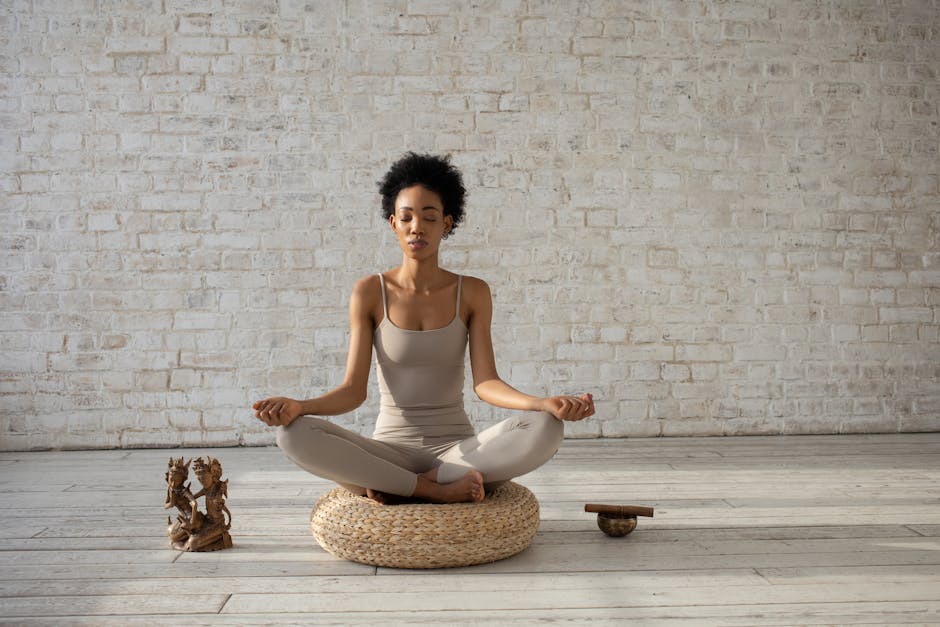Achieving optimal health and fitness doesn’t have to be an overwhelming task. In fact, incorporating a simple, consistent exercise routine into your daily life can make a world of difference. Whether you’re aiming to improve your physical well-being, boost your mental health, or enhance your long-term quality of life, a daily exercise regimen can be the key to unlocking your full potential.
In this article, we’ll explore the numerous benefits of regular physical activity, guide you through the process of creating your perfect workout plan, and provide you with the essential tools and techniques to get started on your fitness journey. By the end, you’ll be well on your way to a healthier, more active lifestyle that can positively impact every aspect of your life.
Key Takeaways
- Incorporating a daily exercise routine can greatly improve your overall health and well-being.
- A consistent fitness regimen offers both physical and mental health benefits, including increased strength, improved cardiovascular function, and enhanced mood.
- Creating a personalized workout plan that fits your lifestyle and preferences is the key to maintaining a long-term active lifestyle.
- Investing in the right equipment and setting up a dedicated workout space can help you stay motivated and engaged in your fitness journey.
- Finding the optimal time of day to exercise, whether it’s in the morning or evening, can maximize the effectiveness of your workouts.
Understanding the Benefits of Regular Exercise
Maintaining a consistent workout plan is crucial for your health and wellness. Regular exercise not only improves your physical well-being but also provides significant mental health advantages and long-term health benefits. Let’s dive deeper into the various perks of an active lifestyle.
Physical Benefits of Consistent Workouts
Engaging in regular physical activity can significantly enhance your cardiovascular health. Exercise helps strengthen your heart, lower blood pressure, and improve blood circulation throughout the body. Additionally, a consistent workout plan can aid in weight management, as it helps burn calories and maintain a healthy metabolism.
Mental Health Advantages
Exercise is not just good for your body; it also has a profound impact on your mental well-being. Regular physical activity has been shown to reduce stress, anxiety, and depression. The endorphins released during a workout can elevate your mood and improve your overall emotional state.
Long-term Health Impact
Consistent exercise habits can have a lasting positive effect on your long-term health. By incorporating physical activity into your daily routine, you can reduce the risk of chronic diseases such as type 2 diabetes, certain types of cancer, and neurodegenerative conditions like Alzheimer’s disease. A commitment to an active lifestyle can contribute to a longer, healthier life.
| Benefit | Description |
|---|---|
| Cardiovascular Health | Strengthens the heart, lowers blood pressure, and improves blood circulation. |
| Weight Management | Helps burn calories and maintain a healthy metabolism. |
| Mental Well-being | Reduces stress, anxiety, and depression by releasing endorphins. |
| Long-term Health | Lowers the risk of chronic diseases and contributes to longevity. |
“Regular exercise is not only great for your body, but it also does wonders for your mental health. Making it a habit can truly transform your overall well-being.”
In conclusion, understanding the comprehensive benefits of regular exercise is crucial for maintaining a healthy and balanced lifestyle. By incorporating a consistent workout plan into your daily routine, you can unlock a wealth of physical, mental, and long-term health advantages.
Creating Your Perfect Daily Exercise Routine
Developing a personalized daily exercise routine is the key to unlocking a sustainable and effective fitness journey. To create your perfect workout plan, consider your individual goals, time constraints, and personal preferences. By tailoring your exercise schedule to your unique needs, you can maximize the benefits and make fitness a seamless part of your lifestyle.
Start by reflecting on your fitness objectives. Are you aiming to build strength, improve cardiovascular health, or simply maintain overall well-being? Identifying your specific goals will guide the selection of exercises and the intensity of your daily workout. Next, assess your available time and choose a fitness regimen that fits comfortably into your daily schedule.
To ensure long-term success, incorporate activities you genuinely enjoy. Whether it’s a brisk walk, a high-intensity interval training session, or a yoga flow, choose exercises that you find engaging and motivating. This will help you stick to your exercise schedule and make fitness a rewarding habit.
Remember, the perfect daily exercise routine is not a one-size-fits-all solution. Experiment, adjust, and refine your plan as needed to find the perfect balance between your goals, time, and personal preferences. With a little effort and creativity, you can unlock the transformative power of a tailored daily workout that energizes both your body and mind.
Essential Equipment for Home Workouts
Creating an effective workout plan doesn’t have to require an extensive home gym. In fact, with just a few essential pieces of equipment, you can achieve a comprehensive exercise routine and reach your fitness goals from the comfort of your own space. Let’s explore the must-have tools and optional advanced gear to elevate your physical activity at home.
Basic Fitness Tools
To get started with your home workout plan, consider these fundamental pieces of equipment:
- Resistance bands – Versatile and compact, resistance bands allow you to target various muscle groups with minimal investment.
- Dumbbells – A set of adjustable or fixed-weight dumbbells enables you to incorporate strength training into your routine.
- Exercise mat – A high-quality exercise mat provides cushioning and traction for floor-based workouts, such as yoga, Pilates, and core exercises.
- Jump rope – This classic cardio tool is an inexpensive way to get your heart rate up and improve coordination.
Optional Advanced Equipment
If you’re looking to expand your home exercise routine, consider these optional upgrades:
- Stationary bike or treadmill – Cardiovascular equipment allows you to incorporate intense physical activity into your workouts.
- Kettlebells – These versatile weights can be used for a wide range of strength and functional training exercises.
- Pull-up bar – Mounted in a doorway, a pull-up bar enables you to perform upper-body exercises like pull-ups and chin-ups.
Setting Up Your Workout Space
Regardless of the equipment you choose, it’s important to create a dedicated and motivating workout plan space at home. Consider the following tips:
- Choose a quiet, well-lit area with enough space to move freely.
- Invest in storage solutions to keep your equipment organized and accessible.
- Personalize your space with motivational cues, such as inspirational quotes or visuals.
- Ensure proper ventilation and consider adding a fan or speaker system to enhance your physical activity experience.
By outfitting your home with the right equipment and setting up an inviting workout space, you’ll be well on your way to achieving your fitness goals through a consistent and effective exercise routine.
Morning vs Evening Workouts: Finding Your Optimal Time
Crafting the perfect daily exercise routine is not a one-size-fits-all endeavor. One crucial factor to consider is the optimal time of day to work out. Whether you prefer morning or evening sessions can significantly impact the effectiveness and sustainability of your daily exercise routine. Let’s explore the pros and cons of each approach to help you determine the best fit for your active lifestyle and exercise habits.
Morning Workouts: Kick-Starting Your Day
Starting your day with a workout can have numerous benefits. Early birds often find that their energy levels are higher in the morning, allowing them to push themselves more during their exercise sessions. Additionally, morning workouts can set a positive tone for the rest of the day, boosting productivity and mood.
Evening Workouts: Winding Down and Destressing
On the other hand, evening workouts can be a perfect way to unwind after a long day. The physical activity can help relieve stress and improve sleep quality, which is essential for overall well-being. Some individuals also find that they have more mental focus and energy in the evenings, leading to more intense and effective workouts.
Ultimately, the choice between morning and evening workouts comes down to personal preference and lifestyle considerations. Experiment with both options to determine which time frame works best for your daily exercise routine and helps you maintain a sustainable active lifestyle.
| Morning Workouts | Evening Workouts |
|---|---|
| Higher energy levels | Stress relief and better sleep |
| Improved productivity and mood | More mental focus and intensity |
| Kickstart your day with a positive tone | Unwind after a long day |
“The best time to work out is the time that works best for you and your schedule.”
Remember, the key to a successful daily exercise routine is finding a time that you can consistently commit to and enjoy. Experiment, be flexible, and listen to your body’s preferences to determine the optimal workout time that supports your active lifestyle and exercise habits.
Warm-Up Exercises to Prevent Injury
Preparing your body for an exercise routine or physical activity is crucial to ensure a safe and effective workout plan. By incorporating a proper warm-up, you can minimize the risk of injury and get the most from your training sessions.
Dynamic Stretching Techniques
Dynamic stretching involves controlled movements that gently stretch and prepare your muscles for the upcoming activity. This type of stretching helps increase blood flow, improve joint range of motion, and activate the muscle groups you’ll be using. Some effective dynamic stretches include:
- Leg swings
- Arm circles
- Ly’s and T’s
- Bodyweight squats
Joint Mobility Exercises
In addition to dynamic stretching, incorporating joint mobility exercises can help improve overall flexibility and range of motion. These exercises target the major joints, such as the shoulders, hips, and ankles, preparing them for the demands of your exercise routine. Examples of joint mobility exercises include:
- Ankle circles
- Ly’s and T’s
- Spinal rotations
- Shoulder rolls
Cardiovascular Preparation
To get your body fully ready for your physical activity or workout plan, it’s important to incorporate a light cardiovascular warm-up. This can be as simple as a brisk walk, light jog, or some jumping jacks. The goal is to gradually increase your heart rate and body temperature, preparing your cardiovascular system for the more intense portions of your session.
Bodyweight Exercises for Beginners
Embarking on a daily workout routine can seem daunting, especially for beginners. However, incorporating bodyweight exercises into your fitness regimen is an excellent way to start your exercise schedule and build a strong foundation. These exercises require no equipment, making them accessible and easy to incorporate into your daily routine.
One of the most effective bodyweight exercises is the classic squat. To perform a proper squat, stand with your feet shoulder-width apart, engage your core, and bend your knees to lower your hips as if you’re sitting back into a chair. Ensure your knees are tracking over your toes, and gradually work on increasing your range of motion.
Another essential exercise is the push-up. Start in a high plank position, with your hands directly under your shoulders. Slowly lower your chest towards the ground, keeping your body in a straight line from head to heels. Push back up to the starting position, engaging your chest and arm muscles.
- Lunges: Stand with your feet hip-width apart, take a big step forward with one leg, and lower your body until your front thigh is parallel to the ground. Alternate legs with each repetition.
- Planks: Hold a high plank position, engaging your core and maintaining a straight line from your head to your heels. Start with 30-second holds and gradually increase the duration.
Incorporating these basic bodyweight exercises into your daily workout can be a game-changer, helping you build strength, improve flexibility, and boost your overall fitness level. Remember to listen to your body, start at a comfortable pace, and gradually increase the intensity and duration of your exercise schedule.
| Exercise | Benefits | Muscles Targeted |
|---|---|---|
| Squats | Improves lower body strength, flexibility, and balance | Quadriceps, Hamstrings, Glutes |
| Push-ups | Strengthens the upper body, core, and improves overall body control | Chest, Shoulders, Triceps |
| Lunges | Targets the lower body, improves balance and stability | Quadriceps, Hamstrings, Glutes |
| Planks | Strengthens the core, improves posture and stability | Abdominals, Back, Shoulders |
Incorporating Cardio Into Your Workout Plan
An effective daily exercise routine should integrate various forms of physical activity, including both strength training and cardiovascular exercise. Incorporating cardio into your workout plan not only improves your overall fitness but also offers a range of health benefits, from better heart health to enhanced weight management.
Low-Impact Cardio Options
If you’re looking for a gentler approach to cardio, there are several low-impact options to consider. These exercises, such as walking, swimming, and cycling, can be just as effective in elevating your heart rate while placing less stress on your joints. Low-impact cardio is an excellent choice for individuals new to exercise or those with existing joint concerns.
High-Intensity Interval Training (HIIT)
On the other hand, high-intensity interval training (HIIT) offers a more challenging and time-efficient approach to cardio. HIIT workouts involve alternating bursts of intense exercise with periods of rest or lower-intensity activity. This approach not only boosts cardiovascular fitness but also helps to improve metabolic function and overall health and wellness.
Measuring Heart Rate Zones
Regardless of the type of cardio you choose, it’s essential to monitor your heart rate to ensure you’re working within the optimal intensity range. By tracking your heart rate zones, you can maximize the benefits of your daily exercise routine and physical activity. This can be done using a heart rate monitor or even a fitness tracker, which can provide valuable insights into your cardiovascular performance.
| Heart Rate Zone | Intensity Level | Benefits |
|---|---|---|
| Zone 1 (50-60% of max HR) | Light | Warm-up, recovery, and fat burning |
| Zone 2 (60-70% of max HR) | Moderate | Cardiovascular endurance and metabolic boost |
| Zone 3 (70-80% of max HR) | Vigorous | Improved VO2 max and anaerobic capacity |
| Zone 4 (80-90% of max HR) | High | Increased fat and calorie burn, enhanced speed and power |
| Zone 5 (90-100% of max HR) | Maximum | Immediate improvements in cardiovascular fitness and stamina |
By understanding and monitoring your heart rate zones, you can tailor your daily exercise routine to achieve your specific fitness goals, whether that’s improving cardiovascular health, boosting metabolism, or enhancing overall physical performance.
Strength Training Fundamentals
Incorporating strength training into your workout plan is an essential component of a well-rounded exercise routine and fitness regimen. This form of training not only builds muscle but also increases bone density, boosts metabolism, and enhances overall physical function. By mastering the fundamentals of strength training, you can unlock the countless benefits it offers and take your fitness to new heights.
One of the key principles of strength training is proper form. Executing exercises with correct technique not only maximizes the effectiveness of the workout but also minimizes the risk of injury. Whether you’re targeting your upper body, lower body, or core, paying attention to your body’s alignment and movement patterns is crucial.
Another important factor in strength training is determining the right number of repetitions (reps) and sets. Generally, lower rep ranges (4-8 reps) with heavier weights are used for building muscle mass, while higher rep ranges (12-15 reps) with lighter weights focus on muscular endurance. Incorporating both approaches into your fitness regimen can lead to a well-rounded and balanced strength training routine.
Progressively increasing the weight, resistance, or difficulty of your strength training exercises is known as progressive overload. This gradual challenge to your muscles is what drives adaptation, allowing you to continually improve your strength and muscle development over time. By consistently pushing yourself, you’ll witness tangible results in your exercise routine.
| Exercise | Muscles Targeted | Recommended Reps |
|---|---|---|
| Squats | Quadriceps, Glutes, Hamstrings | 8-12 |
| Deadlifts | Hamstrings, Glutes, Lower Back | 6-8 |
| Bench Press | Chest, Shoulders, Triceps | 8-10 |
| Pull-ups | Back, Biceps | 6-8 |
Remember, consistency is key when it comes to strength training. By incorporating it into your regular workout plan, you’ll witness significant improvements in your overall fitness regimen and physical capabilities over time.
Tracking Progress and Setting Goals
Measuring your progress and setting realistic fitness goals are essential for maintaining motivation and achieving long-term success in your daily exercise routine. By consistently tracking your performance and milestones, you can gain valuable insights into your progress, identify areas for improvement, and adjust your workout plan accordingly.
Measurement Methods
There are various methods to track your progress, from simple metrics like the number of repetitions or duration of exercises to more advanced measurements such as body composition, strength, and cardiovascular fitness. Consider keeping a detailed fitness journal, using mobile apps to log your workouts, or investing in wearable devices to monitor your heart rate, steps, and other relevant data points.
Goal-Setting Strategies
Establishing well-defined, achievable goals is crucial for maintaining focus and driving your exercise habits forward. Utilize the SMART (Specific, Measurable, Achievable, Relevant, and Time-bound) framework to set goals that align with your fitness aspirations and lifestyle. Remember to celebrate small victories along the way, as this can help sustain your motivation and foster a positive, healthy mindset.
Progress Documentation
Regularly documenting your progress, whether through written logs, visual representations, or a combination of both, can help you track your improvements over time. This documentation can serve as a valuable reference point, allowing you to reflect on your achievements, identify areas of growth, and stay accountable to your fitness objectives.
FAQ
What are the benefits of a daily exercise routine?
A consistent daily exercise routine offers numerous physical and mental health benefits, including improved cardiovascular health, weight management, stress reduction, and enhanced cognitive function. Regular physical activity helps you maintain long-term well-being and overall fitness.
How do I create a personalized daily exercise routine?
To create a personalized daily exercise routine, consider your individual fitness goals, time constraints, and personal preferences. This will help you develop a sustainable and effective workout plan that fits your lifestyle.

What essential equipment do I need for home workouts?
For basic home workouts, essential equipment includes resistance bands, dumbbells, and a yoga mat. More advanced options can include kettlebells, a stationary bike, or a treadmill. The key is to set up a dedicated workout space that is organized and motivating.
Should I work out in the morning or evening?
The optimal time for your daily exercise routine depends on your schedule, energy levels, and personal preferences. Both morning and evening workouts have their advantages, so experiment to find the time that works best for you and your lifestyle.
How do I properly warm up before a workout?
Proper warm-up exercises are crucial to prevent injury and prepare your body for physical activity. This includes dynamic stretching, joint mobility exercises, and light cardiovascular movements to increase blood flow and range of motion.
What are some effective bodyweight exercises for beginners?
Excellent bodyweight exercises for beginners include squats, push-ups, lunges, planks, and mountain climbers. These exercises can be easily incorporated into a daily workout routine and don’t require any additional equipment.
How can I incorporate cardio into my daily routine?
You can incorporate cardio into your daily routine through low-impact exercises like walking, cycling, or swimming, as well as high-intensity interval training (HIIT) workouts. Monitoring your heart rate can help you ensure you’re working within your optimal cardiovascular fitness zones.
What are the fundamentals of strength training?
The fundamentals of strength training include proper form, rep ranges, and progressive overload. Engaging in strength training as part of your daily routine can help build muscle, increase bone density, and improve overall fitness.
How can I track my progress and set achievable fitness goals?
Tracking your progress through measurements, goal-setting, and documentation is essential for maintaining motivation and consistency in your daily exercise routine. This can include monitoring your weight, body composition, or performance metrics, and setting SMART (Specific, Measurable, Achievable, Relevant, and Time-bound) goals.



